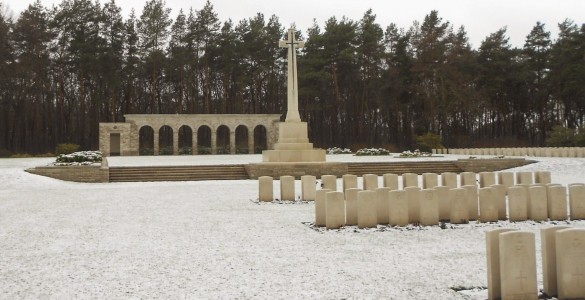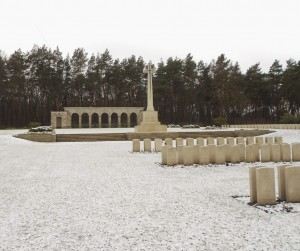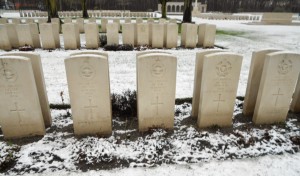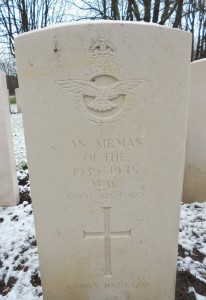Posted on November 19, 2015, 9:42 pm By John Proctor

Convention for the Amelioration of the Condition of the Wounded and Sick in Armies in the Field. Geneva, 27th July 1929.
Article. 3. After each engagement the occupant of the field of battle shall take measures to search for the wounded and dead, and to protect them against pillage and maltreatment.
Whenever circumstances permit, a local armistice or a suspension of fire shall be arranged to permit the removal of the wounded remaining between the lines.
Whenever circumstances permit, a local armistice or a suspension of fire shall be arranged to permit the removal of the wounded remaining between the lines.
* * *
Article. 4. Belligerents shall communicate to each other reciprocally, as soon as possible, the names of the wounded, sick and dead, collected or discovered, together with any indications which may assist in their identification.
They shall establish and transmit to each other the certificates of death.
They shall likewise collect and transmit to each other all articles of a personal nature found on the field of battle or on the dead, especially one half of their identity discs, the other hall to remain attached to the body.
They shall ensure that the burial or cremation of the dead is preceded by a careful, and if possible medical, examination of the bodies, with a view to confirming death, establishing identity and enabling a report to be made.
They shall ensure that the burial or cremation of the dead is preceded by a careful, and if possible medical, examination of the bodies, with a view to confirming death, establishing identity and enabling a report to be made.
They shall further ensure that the dead are honourably interred, that their graves are respected and marked so that they may always be found.
To this end, at the commencement of hostilities, they shall organize officially a graves registration service, to render eventual exhumations possible, and to ensure the identification of bodies whatever may be the subsequent site of the grave.
To this end, at the commencement of hostilities, they shall organize officially a graves registration service, to render eventual exhumations possible, and to ensure the identification of bodies whatever may be the subsequent site of the grave.
After the cessation of hostilities they shall exchange the list of graves and of dead interred in their cemeteries and elsewhere.’

There is no question that Germany sought to meet its obligations to dead Allied airmen under articles 3& 4 of the Geneva Convention during the Second World War. Lists of Allied aircrew killed on operations over enemy territory, received from German sources, were sent through to the Air Ministry in London by the International Red Cross Commission. Telegrams normally listed a number of crews and included date, aircraft type and what befell the crew members – with their identities if known, or stated as unknown if not. The crash location would not be given, nor burial particulars.
The IRCC telegram would be followed up with a ‘Totenliste’ (death list) confirming the information and perhaps adding a burial place. Occasionally aircraft were lost without trace, often airmen could not be identified.
As you may be aware (if you have read ‘Does Life Hold Any More in Store’) the ‘missing’ information was reported back to next-of-kin, updated as confirmation of casualties was received from the IRCC. For the families of many airmen whose deaths had been presumed but not confirmed would still hold out some hope that their boy had not been killed until the war’s end and beyond, as was the case with Jim’s m/u Harold Johnson. Harold’s name had not appeared on the ‘Totenliste’ – by mistake, oversight – perhaps his dog-tags were not found. His family were still uncertain as to his fate until final correspondence passed between them and the Chief of Air Staff, Ottawa in March 1949.
After the war the RAF Missing Research and Enquiry Service sought to investigate losses of aircraft all over Europe and identify remains of deceased airmen and, in a majority of cases, to arrange for re-burial in War Graves Commission Cemeteries. Invariably the MRES investigation teams were faced with the task of sorting through haphazard burials, sometimes with two or three bodies to a grave and many unknown airmen.
The Ives crew were not the only casualties to be taken to Doberitz-Elsgrund for burial after the 30th January Berlin raid. 115 Squadron Lancaster LL648 was also shot down in the target area.
* * *
On 22nd January 1947 F/Lt Angus M Dixon, an investigation officer with 4 MREU, visited the Berlin District of Johannisthal as part of the investigation into the remains of aircrew buried in Doberitz-Elsgrund cemetery. His trip into the Russian occupied sector was ‘to investigate the fate of the crew of Lancaster II, LL648′.
F/Lt Dixon interviewed eye-witnesses to the crash of a large RAF bomber on the late evening of 30th January 1944. Policeman Herr Matthai was on duty at Johannistal police station when he saw and heard an aircraft explode at an altitude he thought to be about 15,000ft. Matthai believed that it had been hit by flak. The main part of the aircraft and the four motors fell about 2km north-west of Johannistal in a small wood known as Honings Heide. Other pieces of debris from the aircraft were recovered over a 2km long swathe. The aircraft burned for some time after hitting the ground.
The following morning a lieutenant from Doberitz aerodrome arrived with a party of men and recorded the numbers from the engines and told Herr Matthai that it was an English bomber – a Lancaster. The policeman’s statement was corroborated by the head gardener from the local cemetery Herr C Grunberg.
The wreckage of the Lancaster was taken to Doberitz aerodrome after eight days. At the time of the investigation ‘there were no identifying particles’ to mark the scene of the crash.
The body of one of the members of the Lancaster’s crew was found, dressed in full flying clothing, in Sudest Allee about 1km north-west of Johannistal. Another body was discovered at Baumschulenweg New Cemetery (2km north-west of Johannisthal) and five more had fallen in the adjacent Baumschulenweg Old Cemetery.
Herr Matthai had been detailed to search the bodies, which he did on the morning of the 31st January. He remembered finding a photograph of ‘a woman with two children standing on a step’ – Mrs Beer & children?, another airman wore a ring (P/O Gladwell was also married), ‘others had a selection of gum, chocolate, soap etc.’ The lieutenant from Doberitz airfield took the collected articles away with him.
Although Herr Matthai recalled that all the crew were wearing flying clothing, he remembered one man in particular as wearing an Irvin flying jacket, his uniform had a single wing brevet with a rank insignia of ‘three stripes and a crown on his sleeves’. He was a ‘large, dark man’ – most likely to have been F/Sgt Todd.
All were wearing parachutes but none were opened, none of the bodies had been burnt. F/Lt Dixon concluded that the concussion of ‘the explosion of the aircraft either killed the crewmen outright or rendered them unconscious with death ensuing as a result of the impact with the ground.’ Herr Matthai also recounted that no identity discs were found but one of the men had a leather name tag on his tunic but he could not remember the name.
A truck came to collect the seven bodies which were taken to Doberitz for burial.
F/Lt Dixon could find no witnesses who were at the burials and so it was not possible to confirm whether the Hicks crew had been afforded ‘military honours or Christian rites’ when they were interred.
That only one RAF aircraft crashed in the vicinity of Johannistal that night was confirmed by Herr Matthai, Herr Grunberg – the gardener, Town Clerk – Frau Capito and Herr Gieszminn – cemetery caretaker – all saw the wreckage the next day. The three gentlemen each saw seven bodies and were told by the German Lieutenant that the aeroplane was a Lancaster. F/Lt Dixon concluded that it was reasonably certain that this was the wreckage and crew of LL648 as stated in German documents and that all the crew had been killed. This was despite a previous IRCC telegram mentioning two crews having been involved.
When bodies were exhumed at Doberitz-Elsgrund Cemetery the investigation team was assisted by about 50 men from the surrounding villages who acted as diggers – none of whom had been present at the burials.
Despite their reputation for accurate record keeping and thoroughness the German searches had overlooked that some of the crew’s dog-tags were present.
When the remains were exhumed over 4th, 6th and 7th December 1946 – NZ421388 F/Sgt Todd, was identified by his identity disc although the ‘T’ was indecipherable and was read as Z412388 A W ODD. The two other bodies in the shared grave (plot 1, row 4, grave 8) were identified as F/O Moore and an A/G whose service number was 1803778.
126822 F/O A W Beer DFC was identified by his name on his shirt collar (officer’s shirt) and on a handkerchief. The two other bodies in the grave (plot 1, row 5, grave 5) were unidentified, one completely unidentifiable, the other had been wearing a dark blue sweater, possibly RAAF issue – which may have been P/O McLoughlin.
Sgt A E Elms was identified as having been buried in grave plot 1, row 5, grave 10 – identification was made by his name and service number marked on his braces.
P/O Farquharson’s identity disc with the remains in grave; plot 1, row 7, grave 14 was partly decomposed but could be read as ‘404170 QUHARSON’.
A/F/Lt H G Hicks was identified by his identity disc and his name and number on his shirt collar – grave: plot 1, row 7, grave 13.
The remains of neither P/O McLoughlin nor P/O Gladwell could be positively identified.
‘It seems reasonably certain that these two officers are buried here, since according to the witnesses the seven crew members were taken away together to Doberitz and five of these have been positively identified there.’
During the investigations in connection with the Hicks crew the remains of several other airmen were encountered – F/O Moore, A/G 1803778; the body in plot1, row 5, grave 11 with initials LDA and a laundry number on his Australian issue khaki shirt; the remains interred with F/O Beer, one unidentifiable and one with a dark blue sweater.

‘It would seem that these bodies were buried with several other crews which accounts for their scattered locations. For this reason one cannot adjudge unknown bodies lying beside a known one to be members of the same crew.’
Hence the reason for so many fallen airmen of the Second World War who have no known grave – their remains could not be positively identified.
The bodies of the Hicks crew were re-interred at the Berlin 1939-1945 War Cemetery:-
DOBERITZ-ELSGRUND BERLIN, HEERSTRASSE
Plot: Row: Grave: Plot: Row: Grave:
1 7 14 P/O Farquharson 5 J 16
1 7 13 F/Lt Hicks 5 J 18
1 5 10 Sgt Elms 7 E 2
1 5 5 (1st body) F/O Beer 7 F 21
1 5 5 (2nd body) unidentified 7 F 22
1 5 5 (3rd body) unidentified 7 F 23
1 4 8 (1st body) F/Sgt Todd 7 D 26
1 4 8 (2nd body) F/O Moore (207 Sqn) 7 D 27
1 4 8 (3rd body) Sgt Parker (44 Sqn) 7 D 25
1 5 11 P/O Anderson (466 Sqn) 7 E 3
The bodies of the Ives crew were also re-buried at the Heerstrasse Cemetery:-
DOBERITZ-ELSGRUND BERLIN, HEERSTRASSE
Plot: Row: Grave: Plot: Row: Grave:
1 5 14 (1st body) 7 E 10*
1 5 14 (2nd body) Sgt Cornes 7 E 9
1 6 14 (1st body) Sgt Savage 7 F 16
1 6 14 (2nd body) 7 F 15*
1 6 13 (1st body) 7 F 14*
1 6 13 (2nd body) 7 F 13*
1 comment Categories: John Proctors Blog


Hmm it seems like your site ate my first comment (it was extremely long) so I guess I’ll just
sum it up what I had written and say, I’m thoroughly enjoying your blog.